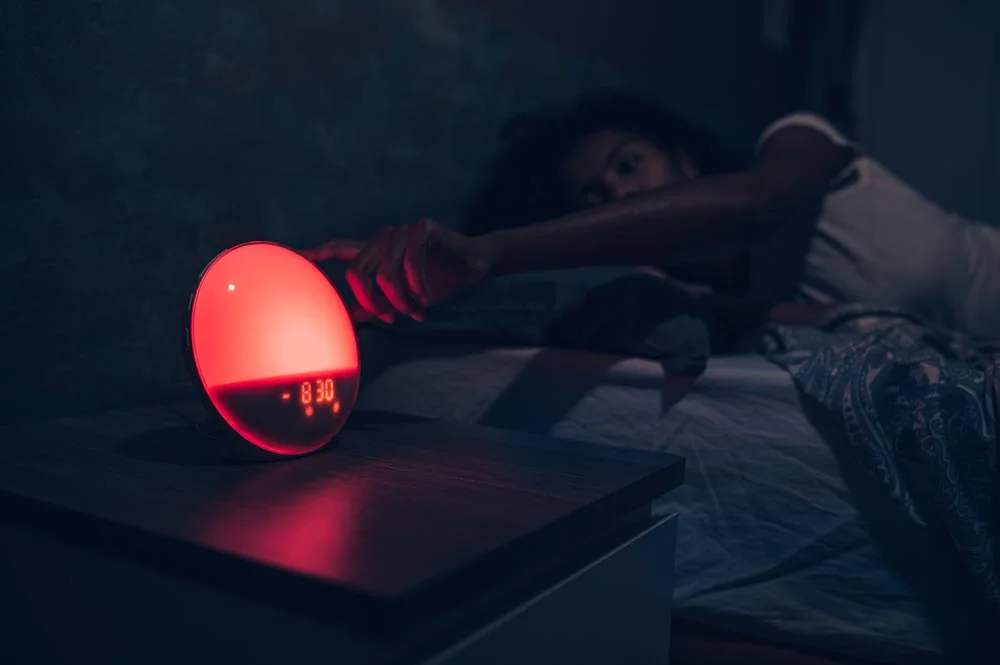
The latest craze in sleep gadgets seems to come from outer space — literally. NASA-inspired red-light sleep devices have become the newest fad claiming to improve sleep, but how do they work?
Some red-light users claim that the light has helped them get out-of-this-world sleep, however, experts say that the research behind red-light therapy for sleep is still lacking.
Let’s look closer at why red-light sleep devices might work in theory.
Helight Sleep recently debuted its take on the red-light sleep device, which they claim will help you get deeper, more restful sleep.
The device emits 14 minutes of pure red light once you turn it on and it automatically dims itself until it’s off after 28 minutes, according to Helight.
Helight’s product is based on NASA’s colored lighting technology, which they use to help regulate astronaut sleep schedules while they are in space.
Why Does NASA Use Red-Light Devices?
As you can imagine, it can be quite difficult for astronauts to get a good night’s sleep while they’re floating around in outer space.
As a result, NASA created a lighting system onboard their space crafts that helps astronauts regulate their circadian rhythm or their sleep/wake cycle.
To help simulate natural sunlight, they turn on blue lights in the morning to help astronauts wake up, white light during the day, and red light at night to help them fall asleep. (1)
This NASA-based technology is the basis of the whole red-light sleep device craze here on Earth. After all, if it helps astronauts fall asleep shouldn’t it help us earthlings fall asleep too?
How Do Red-Light Devices Work?
It’s important to note that there’s a big difference between colored light and the wavelength of light when it comes to sleep effects.
“When we talk about blue light or red light, we’re not talking about a red-colored light bulb. It’s the wavelength of light,” Dr. Raj Dasgupta, Sleepopolis’s Chief Medical Advisor, tells CNN. (2)
Different types of light have different wavelengths, affecting our bodies and brains in different ways. For example, blue light (that pesky light in our phones and TVs) tells our brains that it’s daytime, according to Dr. Dasgupta.
That’s why sleep experts often warn against screen time at night since the blue lights from our phones can make it harder to fall asleep.
As a result, the theory behind red light for sleep is based on the fact that it’s the opposite wavelength of blue light. It’s also thought to mimic a sunset, which may tell our bodies that it’s bedtime.
So if blue light stops us from producing melatonin (the hormone that helps you fall asleep), the theory is that red light will have the opposite effect and help us increase melatonin production.
“The theory behind red light sleep devices is that specific red light wavelengths (around 630 nanometers) might stimulate melatonin production,” Dr. Tom Ingegno, DACM, LAC, tells Sleepopolis.
There’s much that’s still up in the air when it comes to the science behind sleep and red-light devices since the topic hasn’t been studied extensively yet.
Are Red-Light Sleep Devices Effective & Worth it?
As of right now, there haven’t been any larger studies exploring the potential relationship between red light and sleep, but let’s take a look at what we do know.
According to a 2012 Chinese study about women athletes, exposure to red light before sleep helped increase athlete endurance, increased melatonin production, and increased sleep quality. (3)
However, it’s important to note that this study was done on a small scale with only 20 participants, so it can be hard to draw conclusions that apply on a bigger scale.
As a result, some sleep experts are skeptical.
“At best, the evidence for red light sleep devices is inconclusive. While some small studies show potential benefits, some suggest they disrupt the sleep cycle,” says Dr. Ingegno.
Others note that similar to other sleep light devices, red light devices can affect different people in different ways. They point out that not every device will work for everyone.
“When it comes to sleep light devices, effectiveness can vary depending on individual preferences and needs,” Dr. Chelsea Perry, owner of Sleep Solutions and member of the American Academy of Dental Sleep Medicine, tells Sleepopolis.
I know this isn’t the concrete answer that we want to hear, but there are a lot of unknowns when it comes to red light and sleep. More research is needed to understand if red-light devices help sleep.
Potential Pros and Cons of Red-Light Sleep Devices
Even though there isn’t much research about red light and sleep as of right now, here’s what those who’ve tried the Helight Sleep say are the pros and cons of using the red-light device.
Pros:
- Helps some fall asleep faster
- Don’t have to take oral supplements like melatonin
- Helps some sleep deeper ie. less prone to wake up in the middle of the night
- Small, compact for travel
- No app-based subscriptions (can use all of the light’s features right away)
- Easy to use
Cons:
- Limited research to support its effectiveness
- Could take a couple of weeks (21 days) to work
- Hefty price point (Helight currently goes for $140)
As someone who’s always down to try the latest sleep gadget, I can’t help but want to try the red-light device out for myself.
Sources
- Worth K. Casting Light on Astronaut Insomnia: ISS to Get Sleep-Promoting Lightbulbs. Scientific American. Accessed July 1, 2024. https://www.scientificamerican.com/article/casting-light-on-astronaut-insomnia-iss-to-get-sleep-promoting-lightbulbs/#:~:text=The%20fixtures%20have%20three%20modes
- Rogers K. How red light can affect your sleep. CNN. Published June 1, 2023. https://www.cnn.com/2023/06/01/health/red-light-therapy-benefits-sleep-wellness/index.html
- Zhao J, Tian Y, Nie J, Xu J, Liu D. Red Light and the Sleep Quality and Endurance Performance of Chinese Female Basketball Players. Journal of Athletic Training. 2012;47(6):673-678. https://www.ncbi.nlm.nih.gov/pmc/articles/PMC3499892/#:~:text=Key%20Points
Ingegno, Tom. Personal Interview. July 1, 2024.
Perry, Chelsea. Personal Interview. July 2, 2024.


























